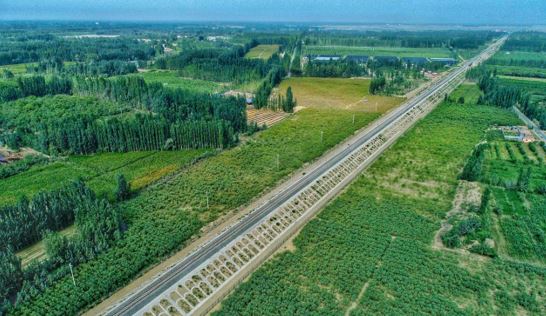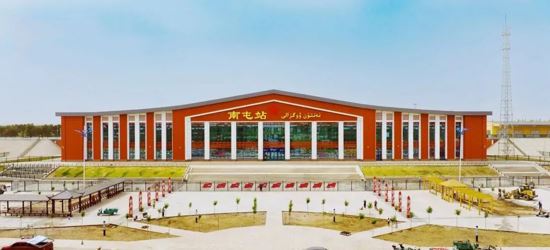By Aldark, People’s Daily
On June 16, the Hotan-Ruoqiang Railway in northwest China’s Xinjiang Uygur autonomous region, the last section of a 2,712-km rail loop line around China’s largest desert, the Taklimakan, opened to traffic.
The newly-opened railway, which links Hotan city, Hotan prefecture and Ruoqiang county, Bayingolin Mongolian autonomous prefecture of Xinjiang, has provided residents in Hotan prefecture’s Lop, Qira, Yutian, and Minfeng counties, and Bayingolin Mongolian autonomous prefecture’s Qiemo county with access to railway services for the first time in history.
The 825-km Hotan-Ruoqiang Railway runs through the southern edge of the Taklimakan Desert, which is the world’s second-largest shifting sand desert and known as the “sea of death”. With 534 km, or 65 percent of the tracks, laid in sandy areas, it is a typical desert railway line.
The construction of the railway in desert, which kicked off in December 2018, relied heavily on cutting-edge technologies and innovative concepts.

Considering the geological characteristics of desert and the problem of severe water scarcity confronting construction tasks and concrete curing along the railroad, companies participating in the project, under the guidance of China State Railway Group Co., Ltd. (China Railway), had the components of 434 bridge piers of the railway manufactured in factory beforehand and then assembled at the construction sites, thus effectively mitigating the effects of severe water scarcity.
In some sandy areas where railway tracks are prone to be buried in sand because of sand dune migration, five viaducts with a total length of 49.7 km have been built to allow sandstorms to pass under the bridges, significantly reducing the impact of sandstorms on the railway line.
Building of a railway in a desert environment necessitates the avoidance and management of desertification, thus participating companies pushed ahead with the construction of the railway and sand control at the same time.
Along the railway, A total of 50 million square meters of grass grids have been laid and 13 million shrubs and trees, including sacsaoul, rose willow, and sea buckthorn, have been planted.

“For the first time in China, sand control projects and construction of the railway were carried out simultaneously. The plants grown during the construction of the railway flourish in desert areas, forming a green belt in desert that protects the railroad against sandstorms,” said Wang Jinzhong, chairman of Xinjiang Hotan-Ruoqiang Railway Co., Ltd.
The operation of the railway is expected to forge a closer economic bond between Xinjiang and other parts of China.
Eight freight trains have been scheduled to run along the Hotan-Ruoqiang Railway, a convenient and fast logistics channel. They can carry featured products of cities along the route, such as red dates, cistanche, roses, and Atlas silk, to the inland areas of the country.
“For featured products in Hotan prefecture, the Hotan-Ruoqiang Railway has ‘cut’ the distance between them and the outside world by more than 1,000 km,” said Wang.
Yiming Maitirouzi, a native of Qiaha township, Qira county, is excited about the railway’s inauguration.

Because of the long transport distance, the man who engages in mutton business and needs to travel between Hotan prefecture and other parts of the country used to be troubled by high transportation costs and difficulty in ensuring the quality of his products.
“Now I can expect high work efficiency and be more confident about my business,” he said happily.
The completion of the Hotan-Ruoqiang Railway also marked the forming of a rail loop line skirting the Tarim Basin in southern Xinjiang, which has made it possible to tour around the southern part of Xinjiang by train.
The route of the Hotan-Ruoqiang Railway covers more than 10 million residents of various ethnic groups in southern Xinjiang, a region with abundant tourism resources and rich folk customs. The railway is expected to further unleash the potential of local tourism industry.

The Hotan-Ruoqiang Railway passes 20 newly built railway stations, nine of which feature distinctive architectural styles.. Yutian railway station in Yutian county features the ancient Silk Road, while the buildings of Qiemo railway station in Qiemo county and Jinshan railway station in the 37th Regiment of the 2nd Division of the Xinjiang Production and Construction Corps highlight the themes of safeguarding oasis and defending the border, respectively.
Companies have made plans for the development of tourist routes around southern Xinjiang and introduced thematic tourism products including tour around the Tarim Basin, adventure tour in desert, and tour featuring folk customs and landscapes of southern Xinjiang.
In addition, some tourist-dedicated trains from other provinces and municipalities of the country now run further to preciously unreachable regions.
As of the end of 2021, the total length of operational railways in Xinjiang had reached 8,151 km. The region, which was once the end of China’s railway network, is gradually becoming a regional railway hub.


